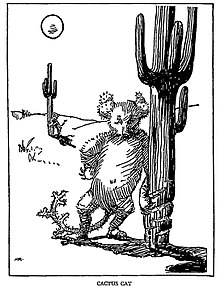
A cactus is a member of the plant family Cactaceae, a family comprising about 127 genera with some 1,750 known species of the order Caryophyllales. The word cactus derives, through Latin, from the Ancient Greek word κάκτος (káktos), a name originally used by Theophrastus for a spiny plant whose identity is now not certain. Cacti occur in a wide range of shapes and sizes. They are native to the Americas, ranging from Patagonia in the south to parts of western Canada in the north, with the exception of Rhipsalis baccifera, which is also found in Africa and Sri Lanka. Cacti are adapted to live in very dry environments, including the Atacama Desert, one of the driest places on Earth. Because of this, cacti show many adaptations to conserve water. For example, almost all cacti are succulents, meaning they have thickened, fleshy parts adapted to store water. Unlike many other succulents, the stem is the only part of most cacti where this vital process takes place. Most species of cacti have lost true leaves, retaining only spines, which are highly modified leaves. As well as defending against herbivores, spines help prevent water loss by reducing air flow close to the cactus and providing some shade. In the absence of true leaves, cacti's enlarged stems carry out photosynthesis.
American mythology is the body of traditional stories pertaining to America's most legendary stories and folktale, dating back to the late 1700s when the first colonists settled. "American mythology" may also refer to the modern study of these representations, and to the subject matter as represented in the literature and art of other cultures in any period.

In American folklore, the hodag is a fearsome critter resembling a large bull-horned carnivore with a row of thick curved spines down its back. The hodag was said to be born from the ashes of cremated oxen, as the incarnation of the accumulation of abuse the animals had suffered at the hands of their masters. The history of the hodag is strongly tied to Rhinelander, Wisconsin, where it was claimed to have been discovered. The hodag has figured prominently in early Paul Bunyan stories.

Cylindropuntia bigelovii, the teddy-bear cholla, is a cholla cactus species native to Northwestern Mexico, and to the United States in California, Arizona, and Nevada.

Opuntia ficus-indica, the Indian fig opuntia, fig opuntia, or prickly pear, is a species of cactus that has long been a domesticated crop plant grown in agricultural economies throughout arid and semiarid parts of the world. O. ficus-indica is the most widespread and most commercially important cactus. It is grown primarily as a fruit crop, and also for the vegetable nopales and other uses. Cacti are good crops for dry areas because they efficiently convert water into biomass. O. ficus-indica, as the most widespread of the long-domesticated cactuses, is as economically important as maize and blue agave in Mexico. Opuntia species hybridize easily, but the wild origin of O. ficus-indica is likely to have been in central Mexico, where its closest genetic relatives are found.

Megalopyge opercularis is a moth of the family Megalopygidae. It has numerous common names, including southern flannel moth for its adult form, and puss caterpillar, asp, Italian asp, fire caterpillar, woolly slug, opossum bug, puss moth, tree asp, or asp caterpillar.
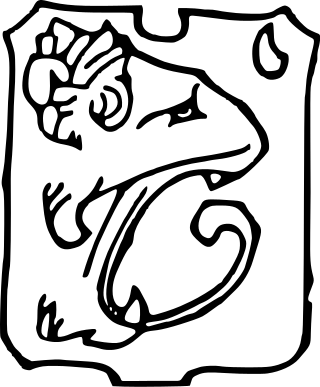
Fearsome Creatures of the Lumberwoods, With a Few Desert and Mountain Beasts is a 1910 fantasy field guide by William Thomas Cox (1878–1961), Minnesota’s first State Forester and Commissioner of Conservation, with illustrations by Coert du Bois and Latin classifications by George Bishop Sudworth The text is a noteworthy resource on folklore, as a century after its initial publication Fearsome Creatures remains one of the principal sources on legendary creatures of the United States and Canada.
The splintercat is a legendary fearsome critter in the folklore of the United States.
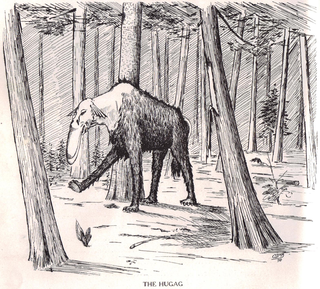
In North American folklore and American mythology fearsome critters were tall tale animals jokingly said to inhabit the wilderness in or around logging camps, especially in the Great Lakes region. Today, the term may also be applied to similar fabulous beasts.
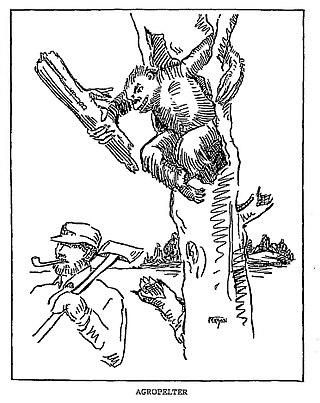
The Agropelter is a mythical fearsome critter said to inhabit hollow trees of the conifer woods from Maine to Oregon. From this vantage point, the creature would await an unwary person and hurl wooden splinters and branches at the intruder. Some have described the creature as being so quick that it has never been seen. One reference describes the creature as having a "slender, wirely body, the villainous face of an ape, and arms like muscular whiplashes, with which it can snap off dead branches and hurl them through the air like shells from a six inch gun."

In American folklore, the axehandle hound is a "fearsome critter" of Minnesota and Wisconsin. The animal resembles a dog with a body axe-like in shape. It has a head shaped like an axe blade, hence the name, complemented by a handle-shaped body atop short stubby legs. It subsists on a diet consisting entirely on the handles of axes which have been left unattended. A nocturnal creature, the axehandle hound travels from camp to camp searching for its next meal. In Minnesota, there is a canoe-access campground named Ax-Handle Hound after the folklore creature. It can be found on the Little Fork River near Voyageurs National Park and very near the town of Linden Grove.

The Hidebehind is a nocturnal fearsome critter from American folklore that preys upon humans that wander the woods, and was blamed for the disappearances of early loggers when they failed to return to camp. As its name suggests, the Hidebehind is said to be able to conceal itself. When an observer attempts to look directly at it, the creature quickly hides behind an object or behind the observer and therefore cannot be directly seen. The Hidebehind supposedly uses this ability to stalk human prey without being observed and to attack them without warning. Said victims, including lumberjacks and others who frequent the forests, are then dragged back to the creature's lair to be devoured. The creature subsists chiefly upon the intestines of its victim and has a severe aversion to alcohol, which is therefore considered a sufficient repellent. Tales of the hidebehind may have been used as an explanation of strange noises in the forest at night. Early accounts describe Hidebehinds as large, powerful animals, despite the fact that no one was able to see them.
In American folklore, a teakettler is a creature with origins in lumberjack culture, specifically the lumber camps of Minnesota and Wisconsin. It is part of a group of related entities collectively as Fearsome Critters. It is said to resemble a small stubby legged dog with the ears of a cat. Its name comes from the sound it makes, which is akin to that of a boiling tea kettle. It only walks backwards, and steam issues from its mouth as it makes its whistle. As the myth goes, only a few lumberjacks have seen one, as they are very shy, but if a boiling kettle is heard and nowhere to be found, it is sure that a Teakettler is nearby.
The glawackus is one of the fearsome critters, a group of legendary creatures in the folklore and traditions of lumberjacks during the 19th and early 20th centuries in North America. The glawackus is described as looking something between a bear, a panther, and a lion. The glawackus is also known as the northern devil cat. It is known for its fearsome screech that compares to the cackle of a hyena. The creature is blind and uses its sense of smell as well as sound waves. Looking into the creature's eyes is said to wipe the victim's memory. It was seen in 1939 in Glastonbury, Connecticut.

The Berbalangs are mythical creatures in Filipino culture, described as ghouls who eat human flesh. They feed by digging up corpses from graveyards or by hunting living humans using flight and other supernatural powers. They are associated with the culture of the smaller towns of Mindanao. The lore on Berbalangs has similarities with that on Aswang creatures.
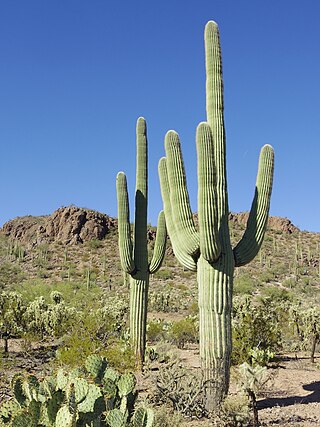
The saguaro is a tree-like cactus species in the monotypic genus Carnegiea that can grow to be over 12 meters tall. It is native to the Sonoran Desert in Arizona, the Mexican state of Sonora, and the Whipple Mountains and Imperial County areas of California. The saguaro blossom is the state wildflower of Arizona. Its scientific name is given in honor of Andrew Carnegie. In 1994, Saguaro National Park, near Tucson, Arizona, was designated to help protect this species and its habitat.

Opuntia, commonly called the prickly pear cactus, is a genus of flowering plants in the cactus family Cactaceae, many known for their flavorful fruit and showy flowers. Prickly pear alone is more commonly used to refer exclusively to the fruit, but may also be used for the plant itself; in addition, other names given to the plant and its specific parts include tuna (fruit), sabra, nopal from the Nahuatl word nōpalli, nostle (fruit) from the Nahuatl word nōchtli, and paddle cactus. The genus is named for the Ancient Greek city of Opus, where, according to Theophrastus, an edible plant grew and could be propagated by rooting its leaves. The most common culinary species is the Indian fig opuntia (O. ficus-indica).

Opuntia macrocentra, the long-spined purplish prickly pear or purple pricklypear, is a cactus found in the lower Southwestern United States and Northwestern Mexico. A member of the prickly pear genus, this species of Opuntia is most notable as one of a few cacti that produce a purple pigmentation in the stem. Other common names for this plant include black-spined pricklypear, long-spine prickly pear, purple pricklypear, and redeye prickly pear.

The Goofus bird is a mythical, backwards-flying bird, originating in lumberjack folklore in North America. It is also known variously as the Filla-ma-loo bird or the Flu-fly bird.
